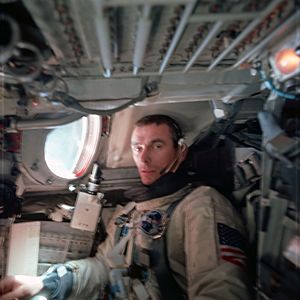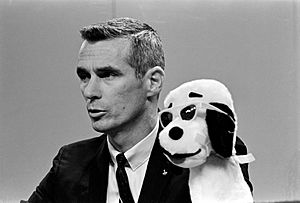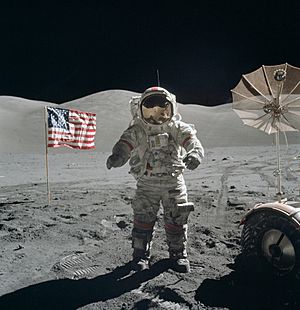Gene Cernan facts for kids
Quick facts for kids
Gene Cernan
|
|
|---|---|

Cernan in 1969
|
|
| Born |
Eugene Andrew Cernan
March 14, 1934 Chicago, Illinois, U.S.
|
| Died | January 16, 2017 (aged 82) Houston, Texas, U.S.
|
| Resting place | Texas State Cemetery |
| Alma mater |
|
| Occupation |
|
| Awards |
|
| Space career | |
| NASA Astronaut | |
| Rank | |
|
Time in space
|
23d 14h 15m |
| Selection | 1963 NASA Group 3 |
|
Total EVAs
|
4 |
|
Total EVA time
|
24 hours 11 minutes |
| Missions | |
|
Mission insignia
|
|
| Retirement | July 1, 1976 |
| Signature | |
 |
|
Eugene "Gene" Cernan (born March 14, 1934 – died January 16, 2017) was an American astronaut, pilot, and engineer. He is famous for being the eleventh person to walk on the Moon. He was also the very last person to walk on the Moon. This happened during the Apollo 17 mission in 1972.
Before becoming an astronaut, Cernan studied electrical engineering at Purdue University. He then joined the U.S. Navy and became a fighter pilot. He also earned a master's degree in aeronautical engineering. He retired from the Navy as a Captain in 1976.
Cernan flew into space three times. He traveled to the Moon twice. His missions included Gemini 9A in 1966, Apollo 10 in 1969, and Apollo 17 in 1972. Apollo 17 was the final time humans landed on the Moon.
Contents
Gene Cernan's Early Life and Education
Growing Up in Illinois
Eugene Andrew Cernan was born in Chicago, Illinois, on March 14, 1934. His father was of Slovak descent, and his mother was of Czech ancestry. He grew up in the towns of Bellwood and Maywood, Illinois. As a child, he was a Boy Scout.
After high school, Cernan attended Purdue University. He studied electrical engineering. While at Purdue, he joined the Naval Reserve Officers Training Corps (NROTC). This program helped him prepare for a career in the Navy. In 1956, he earned his Bachelor of Science degree.
After college, Cernan became an Ensign in the U.S. Navy. He went through flight training to become a pilot. He learned to fly different types of jet aircraft. He became a Naval Aviator, which is a pilot in the Navy.
Flying Fighter Jets
Cernan flew FJ-4 Fury and A-4 Skyhawk jets. He spent many hours flying these powerful aircraft. He also completed his master's degree in aeronautical engineering in 1963. During his time in the Navy, Cernan flew over 5,000 hours. He also landed on aircraft carriers more than 200 times.
Gene Cernan's NASA Career
Becoming an Astronaut
In October 1963, NASA chose Gene Cernan to be an astronaut. He was part of the third group of astronauts selected. This group would work on the Gemini and Apollo space missions.
Gemini 9A Mission
Cernan's first space mission was Gemini 9A in June 1966. He was the pilot for this mission. During this flight, Cernan performed the second American spacewalk. This was only the third spacewalk ever done by a human. It was a difficult spacewalk because he had trouble moving around.
Apollo Program Missions
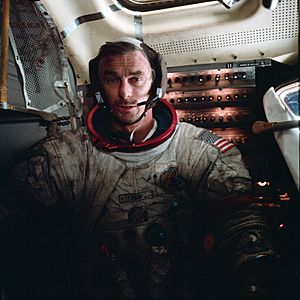

Apollo 10: Lunar Rehearsal
Cernan was the Lunar Module Pilot for Apollo 10. This mission took place in May 1969. Apollo 10 was a practice run for the first Moon landing. Cernan and his commander, Tom Stafford, flew the Lunar Module Snoopy very close to the Moon's surface. They got within 8.5 nmi (about 15.7 kilometers) of the Moon. This mission helped NASA learn important things for Apollo 11 to land on the Moon two months later. Apollo 10 also set a record for the fastest speed ever reached by a crewed vehicle. It went over 39,897 kilometers per hour (24,791 mph) on its way back to Earth.
Apollo 17: The Last Moonwalk
Cernan commanded Apollo 17 in December 1972. This was the final mission of the Apollo program to land on the Moon. Cernan chose to wait for a chance to command his own mission. He flew with Harrison Schmitt, a geologist, as his Lunar Module Pilot.
During their three days on the Moon, Cernan and Schmitt did three spacewalks. They spent about 22 hours exploring the Taurus–Littrow valley. They used the Lunar Roving Vehicle (Moon buggy) to travel over 35 kilometers (22 miles). They collected a record 34 kilograms (75 pounds) of Moon rocks. Cernan even set an unofficial lunar speed record, driving the rover at 11.2 mph (18 km/h).
As Cernan left the Moon for the last time, he said these words:
Bob, this is Gene, and I'm on the surface; and, as I take man's last step from the surface, back home for some time to come—but we believe not too long into the future—I'd like to just (say) what I believe history will record: that America's challenge of today has forged man's destiny of tomorrow. And, as we leave the Moon at Taurus–Littrow, we leave as we came and, God willing, as we shall return, with peace and hope for all mankind. Godspeed the crew of Apollo 17.
Gene Cernan is the last person to have walked on the Moon. Interestingly, both the first person (Neil Armstrong) and the last person to walk on the Moon studied at Purdue University. Cernan is one of only three astronauts who traveled to the Moon twice. He is also one of only twelve people who have ever walked on the Moon.
Life After NASA
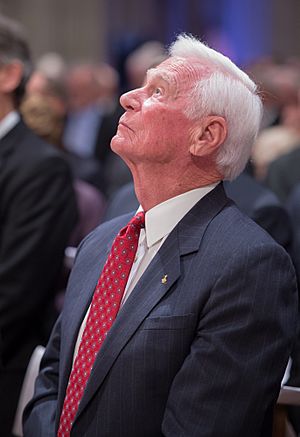
After retiring from NASA and the Navy in 1976, Cernan started his own company, The Cernan Corporation. He also worked as a space expert for ABC News.
In 1999, he wrote a book about his life called The Last Man on the Moon. He also appeared in a documentary film with the same name in 2014. Cernan often spoke about space exploration. He believed it was important for humans to continue exploring space. He gave a eulogy (a speech praising someone who has died) at Neil Armstrong's funeral in 2012.
Personal Life
Gene Cernan was married twice. He had one daughter, Tracy, from his first marriage. He also had two step-daughters from his second marriage.
Cernan passed away in Houston, Texas, on January 16, 2017, at the age of 82. He was buried with full military honors at the Texas State Cemetery.
Organizations and Awards
Organizations Gene Cernan Was a Member Of
Cernan was a member of several important groups, including:
- American Astronautical Society
- Society of Experimental Test Pilots
- Tau Beta Pi (National Engineering Society)
- The Explorers Club
Awards and Honors Received by Cernan
Gene Cernan received many awards for his service and achievements, such as:
- Navy Distinguished Service Medal
- Distinguished Flying Cross
- NASA Distinguished Service Medal
- NASA Exceptional Service Medal
- Wright Brothers Memorial Trophy (2007)
- Inducted into the U.S. Astronaut Hall of Fame
- Inducted into the International Air & Space Hall of Fame (2007)
- Inducted into the National Aviation Hall of Fame (2000)
- The Cygnus CRS OA-8E cargo spacecraft was named the S.S. Gene Cernan in his honor in 2017.
See also
 In Spanish: Eugene Cernan para niños
In Spanish: Eugene Cernan para niños
- List of spaceflight records
- The Astronaut Monument, Iceland
- Cernan Earth and Space Center, a planetarium named after him in Illinois.


